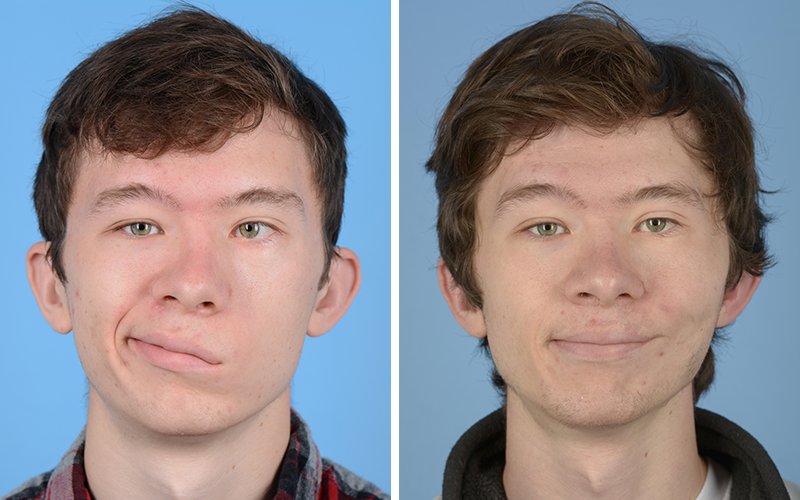Otolaryngology–Head and Neck Surgery
Facial Nerve Tumors
Overview
The two most common facial nerve tumors are facial nerve schwannomas and geniculate ganglion hemangioma. Facial nerve schwannomas are tumors that arise from Schwann cells, which are the supporting cells of all nerves, and are found all the way along the course of any nerve in the body. The geniculate ganglion hemangioma are lesions that represent vascular malformations that occur in and around the bone at one specific area along the course of the facial nerve, called the geniculate ganglion.
Facial Nerve Schwannomas
Common Symptoms
Typically, when an individual has a facial nerve schwannoma, they develop very gradual facial weakness, that is continuously progressive but so slow that it is hardly noticeable.
A common story might involve an individual noticing that their eyes are not closing properly, and then the following year starting to notice their smile looks different in the mirror. Over time, their facial asymmetry becomes noticeable enough that they seek medical attention and if the proper radiology studies are performed, the tumor will be identified.
Treatment Options
While facial nerve schwannomas are benign, they can cause irreversible facial nerve weakness. When they appear, they usually require removal, which might put hearing at risk. In terms of presentation, there are instances where people have very sudden onset facial weakness, which at first glance appears to be Bell’s palsy. However, when the patient does not experience recovery over the expected time course, further examines are performed that ultimately reveals a schwannoma.
Once facial nerve schwannomas cause facial nerve weakness, the recovery process requires medical intervention. In order to improve facial function, the patient will likely require treatment of the tumor either with surgery or radiation therapy. They will also undergo reconstruction of the nerve with a cable graft, using a piece of nerve from someplace else in the body. Often this surgical procedure is accompanied by other maneuvers that will also improve facial function. Every case of facial nerve schwannoma is somewhat different, and care is highly individualized to patient age and tumor location, among other considerations.

Geniculate Ganglion Hemangioma
Common Symptoms
These tumors can present with slow onset facial paralysis, much like schwannomas, or they can present with an episode of acute facial paralysis that then recovers, but returns again and again. If a patient has multiple episodes of facial weakness on a single side, this tumor could be the culprit. Luckily, this tumor is also benign, and we only remove a geniculate ganglion hemangioma when it looks like it might cause damage to adjacent structures that could affect hearing, balance and other important functions, or if it’s determined that the best chance for good facial function involves tumor removal.
Treatment Options
Over the past decade, there has been a great deal of interest in removing geniculate ganglion hemangiomas, while leaving the adjacent attenuated facial nerve in continuity. This has resulted in significantly improved facial nerve outcomes from prior management, which used to involve resecting everything including the tiny intact strand of facial nerve going through that area.
Our Team
The Facial Nerve Centeris staffed by surgeons, physical therapists, physician assistants and other medical specialists skilled in the evaluation and treatment of facial paralysis. Our team includes Kerry Shanley Camp, PA-C, Madeline Macaluso, FNP-BC, Julia Mellon, NP-C, and Mara Robinson, PT, MS. This combination of medical expertise allows us to help patients improve their appearance, facial function, non-verbal communication and overall well-being.

